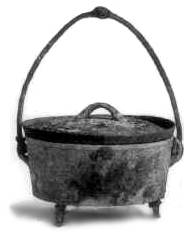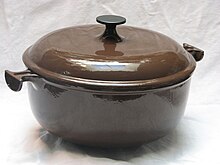Cast-iron cookware
Heavy-duty
.History
This section needs additional citations for verification. (February 2021) |

In Asia, particularly China, India, Korea and Japan, there is a long history of cooking with cast-iron vessels. The first mention of a cast-iron kettle in English appeared in 679 or 680, though this wasn't the first use of metal vessels for cooking. The term pot came into use in 1180. Both terms referred to a vessel capable of withstanding the direct heat of a fire.[1] Cast-iron cauldrons and cooking pots were valued as kitchen items for their durability and their ability to retain heat evenly, thus improving the quality of cooked meals.
In Europe and the United States, before the introduction of the kitchen stove in the middle of the 19th century, meals were cooked in the hearth, and cooking pots and pans were either designed for use in the hearth, or to be suspended within it. Cast-iron pots were made with handles to allow them to be hung over a fire, or with legs so that they could stand in the coals. In addition to Dutch ovens with three or four feet, which Abraham Darby I secured a patent in 1708 to produce,[2] a commonly used cast-iron cooking pan called a spider had a handle and three legs allowing it to stand upright over campfires as well as in the coals and ashes of a fireplace.
Cooking pots and pans with legless, flat bottoms came into use when cooking stoves became popular; this period of the late 19th century saw the introduction of the flat cast-iron
Cast-iron cookware was especially popular among homemakers during the first half of the 20th century. It was a cheap, yet durable cookware. Most American households had at least one cast-iron cooking pan. Popular manufacturers included Griswold, which began production in 1865, Wagner in 1891, and Blacklock Foundry in 1896. The 20th century also saw the introduction and popularization of enamel-coated cast-iron cookware.
Cast iron fell out of favor in the 1960s and 1970s, as
Today, of the large selection of cookware that can be purchased from kitchen suppliers, cast iron comprises only a small fraction. However, the durability and reliability of cast iron as a cooking tool has ensured its survival. Cast-iron pots and pans from the 19th and 20th century continue to see daily use to the present day. They are also highly sought after by antique collectors and dealers.
Surface
Bare cast iron
Cast iron's ability to withstand and maintain very high cooking temperatures makes it a common choice for searing or frying, and its excellent heat retention makes it a good option for long-cooking stews or braised dishes.[5] Because cast-iron skillets can develop a "non-stick" surface when cared for properly, they are excellent for frying potatoes or preparing stir-fries. Some cooks consider cast iron a good choice for egg dishes, while others feel the iron adds an off-flavor to eggs. Other uses of cast-iron pans include baking, for instance for making cornbread, cobblers and cakes.[citation needed]
Most bare cast-iron pots and pans are cast as a single piece of metal, including the handle. This allows them to be used on both the stovetop and in the oven. Many recipes call for the use of a cast-iron skillet or pot, especially so that the dish can be initially seared or fried on the stovetop then transferred into the oven, pan and all, to finish baking.[6] Likewise, cast-iron skillets can double as baking dishes. This differs from many other cooking pots, which have varying components that may be damaged by the excessive temperatures of 400 °F (200 °C) or more.[citation needed]
Cast iron is a poor heat conductor compared to copper and aluminum, and this can result in uneven heating if a cast-iron pan is heated too quickly or on an undersized burner.[7] Cast iron has a higher heat capacity than copper but a lower heat capacity than stainless steel or aluminum.[8] However, cast iron is denser than aluminum and stores more heat per unit volume. Additionally, cast-iron pans are typically thicker than similar sized pans of other materials. The combination of these factors results in cast-iron pans being capable of storing more heat longer than copper, aluminum, or stainless steel pans.[9] Slow heating over an appropriate sized burner (or in an oven) can lead to a more even temperature distribution. Due to the thermal mass of cast-iron utensils, especially heavy duty pots and pans, they can retain heat for a long time, and continue cooking food after the heat source has been removed.
Enameled cast iron

Enameled cast iron is cast iron that has a vitreous enamel glaze applied to the surface. The fusion of the glaze with the cast iron prevents rusting, eliminates the need to season the metal, and allows more thorough cleaning.[10] Enameled cast iron is excellent for slow cooking and drawing flavor from foods.[11] Furthermore, cadmium pigments used in the enameling process are resistant to temperatures of 1,700 to 2,300 °F (900 to 1,280 °C) and can produce vibrant colors.[12]
While enamel-coated cast iron does not have the seasoning and cleaning issues of bare cast iron, a similar style of enamel-coated cast iron can cost three or four times its bare cast-iron counterpart. For those seeking to reduce iron in their diet, enameled cast iron limits the leaching of dietary iron into food. However, some of the benefits of bare cast iron, such as the ability to withstand searing heat and resist sticking, are lost through enameling. In addition, chipping of the enamel coating can occur if the pan is dropped, overheated, or cold water is added to a hot pot.[citation needed]
Some popular brands of enameled cookware include Le Creuset, Descoware, Cousances, and Druware.
Seasoning
A
Experts advise against placing a seasoned pan in a conventional dishwasher.[17][18] While some food writers advise against all use of detergent for seasoned pans, tests by America's Test Kitchen found that small amounts of soap do not damage the seasoning.[19] Exposure to acidic foods, such as tomatoes, damages the seasoning and the cookware may need to be re-seasoned again over time.[20] Though some writers recommend completely avoiding cooking acidic foods in seasoned pans, America's Test Kitchen found that cooking acidic foods for short periods of time had no noticeable effect.[19]
Cleaning
Because other cookware cleaning techniques like scouring or washing in a dishwasher can remove or damage the seasoning on a bare cast-iron pan, experts advise not cleaning these pans like most other cookware. Some chefs advocate simply wiping them out after use, or washing them with hot water and a stiff brush.
Health effects
An
Laboratory tests conducted by America's Test Kitchen found that an unseasoned cast-iron skillet leached significant iron into tomato sauce (10.8 mg/100 g) while a seasoned cast-iron pan leached only a small amount.[19]
See also
- Chugun, Russian cast-iron crock
- Cookware and bakeware
- List of cast-iron cookware manufacturers
- List of cooking vessels
- Non-stick surface
- Non-stick pan
References
- ISBN 978-1-55728-690-1.
- ISBN 978-1-55728-690-1.
- ^ Carroll, Louise. "Skilled in skillets: Dentist's hobby forged in cast iron history". The Times. Retrieved May 9, 2018.
- ^ Park, Eleanore (April 12, 2018). "Eat Joyfully, and Other Wise Advice form Nigella Lawson". Wall Street Journal. Retrieved May 9, 2018.
- ^ "Love Your Pan: What to Cook (and What Not to) in a Cast Iron". Bon Appétit. November 13, 2014. Retrieved September 16, 2019.
- ^ "50 Cast-Iron Skillet Recipes". Bon Appétit. November 10, 2014. Retrieved September 16, 2019.
- ^ "A Cast-Iron Skillet Is the Only Kitchen Tool You Need". Vogue. April 21, 2014. Retrieved September 16, 2019.
- ^ Chu, Michael. "Common Materials of Cookware - Equipment & Gear". Cooking For Engineers. Retrieved September 16, 2019.
- ^ "Heavy Metal: the Science of Cast Iron Cooking". Cooking Issues. February 16, 2010. Retrieved September 16, 2019.
- ^ "Use & Care: Enameled Cast Iron Use & Care". lodgemfg.com. Archived from the original on October 26, 2019. Retrieved May 9, 2018.
- ^ Sherman, Elisabeth. "This Is Nigella Lawson's Favorite Cookware". Food and Wine. Food & Wine. Retrieved May 9, 2018.
- ^ "Why Use Enameled Cast Iron Cookware? (5 Reasons)". Home Cook World. Retrieved July 19, 2021.
- ^ "How to season a cast iron pan". Popular Science. February 24, 2021. Retrieved July 17, 2022.
- ^ "The Science of Cast Iron Seasoning". Lodge Cast Iron. July 1, 2020. Retrieved July 17, 2022.
- ^ "How Bad Is It Really to Cook in Cast-Iron Pans?". LIVESTRONG.COM. Retrieved July 18, 2022.
- ^ "Regular vs. enameled cast iron: How they compare for cooking and cleaning". The Washington Post.
- ^ Watsky, David. "How to Clean a Cast-Iron Skillet (and How Not to)". CNET. Retrieved July 18, 2022.
- ^ Clark, Christine. "How to properly season a cast iron skillet at home". Insider. Retrieved July 18, 2022.
- ^ a b c "The Truth About Cast Iron". America's Test Kitchen. Retrieved December 14, 2020.
- ^ Chodosh, Sara (November 8, 2019). "Seasoning your cast iron pan isn't enough". Popular Science. Retrieved December 14, 2020.
- ^ "Use and care for Lodge Seasoned Cast Iron". Archived from the original on May 12, 2013. Retrieved April 23, 2013.
- ^ "Using and Caring For Your Cast-Iron Skillet". August 8, 2015. Retrieved February 29, 2008.
- ^ "YouTube: Good Eats Episode 1 Pt.2 "Steak Your Claim"". YouTube.[dead YouTube link]
- ^ "Techniques for Restoring an old Cast-Iron Skillet". November 7, 2015. Retrieved December 30, 2007.
- PMID 12859709.
- ^ Patel, Kamal (June 8, 2016). "Are cast iron pans unsafe?". Examine.com. Retrieved November 26, 2018.
External links
![]() Media related to Cast iron pots and pans at Wikimedia Commons
Media related to Cast iron pots and pans at Wikimedia Commons
